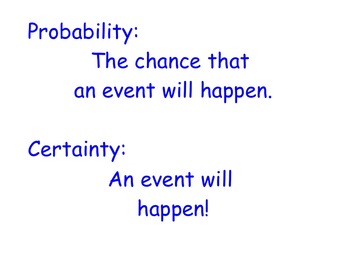7th Grade CCSS Probability Unit Lessons
J Thompson
46 Followers
Grade Levels
6th - 8th
Subjects
Resource Type
Standards
CCSS7.SP.A.1
CCSS7.SP.A.2
CCSS7.SP.B.3
CCSS7.SP.B.4
CCSS7.SP.C.5
Formats Included
- NOTEBOOK (SMARTboard) File
Pages
185 pages
J Thompson
46 Followers
Description
Complete 7th Grade CCSS Probability Unit Lessons.
This download includes all the lessons for the 7th grade probability unit and homework for each lesson. The entire lesson progression can be accessed for free on my site.
These lessons can be used independently or with video lessons that are available on my site. The video lessons are exceptionally useful with students that have been absent or are more advanced and need an independent study unit.
This download includes all the lessons for the 7th grade probability unit and homework for each lesson. The entire lesson progression can be accessed for free on my site.
These lessons can be used independently or with video lessons that are available on my site. The video lessons are exceptionally useful with students that have been absent or are more advanced and need an independent study unit.
Total Pages
185 pages
Answer Key
N/A
Teaching Duration
N/A
Report this resource to TPT
Reported resources will be reviewed by our team. Report this resource to let us know if this resource violates TPT’s content guidelines.
Standards
to see state-specific standards (only available in the US).
CCSS7.SP.A.1
Understand that statistics can be used to gain information about a population by examining a sample of the population; generalizations about a population from a sample are valid only if the sample is representative of that population. Understand that random sampling tends to produce representative samples and support valid inferences.
CCSS7.SP.A.2
Use data from a random sample to draw inferences about a population with an unknown characteristic of interest. Generate multiple samples (or simulated samples) of the same size to gauge the variation in estimates or predictions. For example, estimate the mean word length in a book by randomly sampling words from the book; predict the winner of a school election based on randomly sampled survey data. Gauge how far off the estimate or prediction might be.
CCSS7.SP.B.3
Informally assess the degree of visual overlap of two numerical data distributions with similar variabilities, measuring the difference between the centers by expressing it as a multiple of a measure of variability. For example, the mean height of players on the basketball team is 10 cm greater than the mean height of players on the soccer team, about twice the variability (mean absolute deviation) on either team; on a dot plot, the separation between the two distributions of heights is noticeable.
CCSS7.SP.B.4
Use measures of center and measures of variability for numerical data from random samples to draw informal comparative inferences about two populations. For example, decide whether the words in a chapter of a seventh-grade science book are generally longer than the words in a chapter of a fourth-grade science book.
CCSS7.SP.C.5
Understand that the probability of a chance event is a number between 0 and 1 that expresses the likelihood of the event occurring. Larger numbers indicate greater likelihood. A probability near 0 indicates an unlikely event, a probability around 1/2 indicates an event that is neither unlikely nor likely, and a probability near 1 indicates a likely event.




